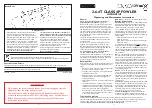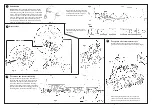
3
2
When fitting the replacement motor, make sure
the worm and worm wheel are meshed correctly
before screwing the motor bracket back in place.
Fig. 2
Fig. 1
Fig. 3
Fig. 7
Fig. 8
Lubrication
IMPORTANT – Only apply small single drops of light
machine oil to the places indicated in red. This is best
achieved by making a simple oil “dropper” as illustrated
in Fig.1. Insert a straightened paper clip into a cork and
use a bottle cap as a container for the oil. A small drop
of oil can then be picked up by the dropper and applied
in exactly the right place. Immediately wipe off any
excess oil, especially from the locomotive and tender
bodies. Only lubricate moving parts.
Apply one drop of oil to each of the
valve gear and connecting rod pivot
points indicated in red in Fig.2, on
both sides of the locomotive.
Apply one drop of oil to each of
the axle bearings indicated in red.
(See Fig.3).
To remove the locomotive body
Turn the locomotive upside down and remove
the screw from the rear bogie. (Fig.6). Turn the
locomotive the right way up and ease the rear
end of the chassis downwards from the body.
When the rear of the chassis is clear of the body,
pull the chassis backwards to disengage the front
chassis lugs from the ftont of the body. (Fig.7)
To replace the locomotive motor
Remove the front and rear motor bracket screws.
The motor can now be lifted clear and replaced. (Fig.8).
Fig. 6
Accessories
Fig. 4
Fig. 5
1
3
4
2
EITHER / OR




















